Creating Q*Bert and Other Classic Video Arcade Games
 Santa Monica Press publishes Warren Davis’ career memoir, “Creating Q*Bert and Other Classic Video Arcade Games“. Davis recalls his work on such ’80s and ’90s arcade games as Q*Bert, Exterminator, Terminator 2, and Revolution X, as well as numerous games and game concepts that never saw the light of day.
Santa Monica Press publishes Warren Davis’ career memoir, “Creating Q*Bert and Other Classic Video Arcade Games“. Davis recalls his work on such ’80s and ’90s arcade games as Q*Bert, Exterminator, Terminator 2, and Revolution X, as well as numerous games and game concepts that never saw the light of day.
Chuck Peddle, microcomputer pioneer, dies
 The chief designer of the 6502 microprocessor (a device credited with breaking Intel’s near-monopoly on the market and kick-starting the personal computer revolution), Chuck Peddle dies at the age of 82. Having already gained experience as part of the team that developed Motorola’s 6800 chip, Peddle realized that there was a need for a cheaper alternative. (At over $300 upon its introduction in 1973, the 6800 was still prohibitively expensive.) Motorola showed no interested in developing an inexpensive alternative, so Peddle defected to rival chip maker MOS, where he brought the 6502 chip to market. Within a few years of its introduction, the 6502 was already the heart of the Apple II, the earliest Atari home computers, the Commodore VIC-20, and the BBC Micro. Variants of the 6500 processor family powered the Commodore 64, the Atari VCS, and the Nintendo Entertainment System, among countless others. He was often credited as the father of the personal computer.
The chief designer of the 6502 microprocessor (a device credited with breaking Intel’s near-monopoly on the market and kick-starting the personal computer revolution), Chuck Peddle dies at the age of 82. Having already gained experience as part of the team that developed Motorola’s 6800 chip, Peddle realized that there was a need for a cheaper alternative. (At over $300 upon its introduction in 1973, the 6800 was still prohibitively expensive.) Motorola showed no interested in developing an inexpensive alternative, so Peddle defected to rival chip maker MOS, where he brought the 6502 chip to market. Within a few years of its introduction, the 6502 was already the heart of the Apple II, the earliest Atari home computers, the Commodore VIC-20, and the BBC Micro. Variants of the 6500 processor family powered the Commodore 64, the Atari VCS, and the Nintendo Entertainment System, among countless others. He was often credited as the father of the personal computer.
Break Out: How The Apple II Launched The PC Gaming Revolution
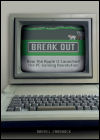 Schiffer publishes David L. Craddock’s non-fictional collection of essays on the stories and creators behind Apple II computer games, “Break Out: How The Apple II Launched The PC Gaming Revolution “. The book profiles the creators and the stories behind such popular titles as Ultima, The Oregon Trail, Pinball Construction Set, Wizardry, Zork, Lode Runner, and more.
Schiffer publishes David L. Craddock’s non-fictional collection of essays on the stories and creators behind Apple II computer games, “Break Out: How The Apple II Launched The PC Gaming Revolution “. The book profiles the creators and the stories behind such popular titles as Ultima, The Oregon Trail, Pinball Construction Set, Wizardry, Zork, Lode Runner, and more.
8-Bit Weapon: Disassembly Language, Vol. 1
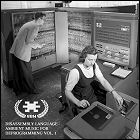 Chiptune music duo 8 Bit Weapon releases an all-instrumental album of ambient electronic music, Disassembly Language: Ambient Music for Deprogramming, Vol. 1, created entirely via the SID sound chip on vintage Commodore 64 computers.
Chiptune music duo 8 Bit Weapon releases an all-instrumental album of ambient electronic music, Disassembly Language: Ambient Music for Deprogramming, Vol. 1, created entirely via the SID sound chip on vintage Commodore 64 computers.
Douglas E. Smith, Lode Runner creator, dies
 The creator and programmer of Lode Runner, Douglas E. Smith, dies at the age of 53. A spare-time creation that became an all-consuming passion for Smith, Lode Runner sparked a nearly unprecedented bidding war among major computer game publishers in 1983. At the time of Smith’s death, Lode Runner has been ported to most major game and computer systems over the past 31 years.
The creator and programmer of Lode Runner, Douglas E. Smith, dies at the age of 53. A spare-time creation that became an all-consuming passion for Smith, Lode Runner sparked a nearly unprecedented bidding war among major computer game publishers in 1983. At the time of Smith’s death, Lode Runner has been ported to most major game and computer systems over the past 31 years.
Jack Kilby, integrated circuit inventor, dies
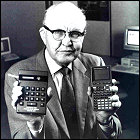 Computer pioneer Jack Kilby, a Nobel Prize winner for his part in creating the integrated cicruit, dies of cancer at the age of 81. A long-time employee of Texas Instruments, he co-invented the integrated circuit, which made the current advances in miniturization of computer technology possible. (Prior to that, even minimal computing power often occupied an entire room.) He also counted the handheld calculator among his inventions. Though he retired from TI in the early 80s, he continued to consult for the company until the time of his death.
Computer pioneer Jack Kilby, a Nobel Prize winner for his part in creating the integrated cicruit, dies of cancer at the age of 81. A long-time employee of Texas Instruments, he co-invented the integrated circuit, which made the current advances in miniturization of computer technology possible. (Prior to that, even minimal computing power often occupied an entire room.) He also counted the handheld calculator among his inventions. Though he retired from TI in the early 80s, he continued to consult for the company until the time of his death.
Multiple Arcade Machine Emulator
 Programmer Nicola Salmoria releases the earliest version of the Multiple Arcade Machine Emulator, or MAME, a freeware PC program which allows users to obtain dumps of the original 1970s and 1980s arcade game ROM chips which MAME interprets, emulating the original hardware architecture to allow play of those games with remarkable fidelity to the original graphics and sounds. This kick-starts a golden age of computer emulation of classic video games and game systems, with the average desktop computer now sporting enough memory to allow for accurate emulation. The release of MAME also ignites an ongoing controversy about the legality of downloading games whose original manufacturers are no longer exploting their intellectual property (or, in some cases, no longer exist as corporate entities).
Programmer Nicola Salmoria releases the earliest version of the Multiple Arcade Machine Emulator, or MAME, a freeware PC program which allows users to obtain dumps of the original 1970s and 1980s arcade game ROM chips which MAME interprets, emulating the original hardware architecture to allow play of those games with remarkable fidelity to the original graphics and sounds. This kick-starts a golden age of computer emulation of classic video games and game systems, with the average desktop computer now sporting enough memory to allow for accurate emulation. The release of MAME also ignites an ongoing controversy about the legality of downloading games whose original manufacturers are no longer exploting their intellectual property (or, in some cases, no longer exist as corporate entities).
More about arcade games in Phosphor Dot Fossils
The LogBook… on the web!
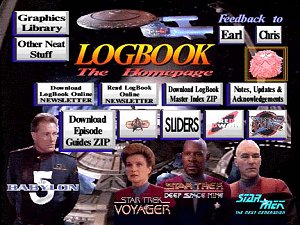 Previously distributed between computer bulletin board systems and FidoNet BBS nodes as a series of text files, theLogBook makes its debut on the world wide web, on a slice of web space borrowed from the University of Arkansas. In most cases, the episode guides previously distributed via BBS are simply the text files posted on the web, though conversion into HTML documents gradually takes place. The gigantic full-screen graphical menu overwhelms many a dial-up web surfer and is quickly replaced with a simpler, text-based menu.
Previously distributed between computer bulletin board systems and FidoNet BBS nodes as a series of text files, theLogBook makes its debut on the world wide web, on a slice of web space borrowed from the University of Arkansas. In most cases, the episode guides previously distributed via BBS are simply the text files posted on the web, though conversion into HTML documents gradually takes place. The gigantic full-screen graphical menu overwhelms many a dial-up web surfer and is quickly replaced with a simpler, text-based menu.
The World Wide Web
 The World Wide Web is born as Tim Berners-Lee shows off his concept for implementing hypertext, consisting of cross-linked documents, on the internet. At the time of his demonstration, the net’s primary functions are Gopher, Telnet and Usenet, but as those services do not provide a simple, user-friendly experience for providing amusingly captioned cat pictures to the public, “the web”, also known as “the WWW”, quickly gains traction and prominence. While the internet’s infrastructure can trace its origins to the 1960s and ARPAnet, this marks the dawn of the public-facing internet (which now, of course, includes the site you are reading right now).
The World Wide Web is born as Tim Berners-Lee shows off his concept for implementing hypertext, consisting of cross-linked documents, on the internet. At the time of his demonstration, the net’s primary functions are Gopher, Telnet and Usenet, but as those services do not provide a simple, user-friendly experience for providing amusingly captioned cat pictures to the public, “the web”, also known as “the WWW”, quickly gains traction and prominence. While the internet’s infrastructure can trace its origins to the 1960s and ARPAnet, this marks the dawn of the public-facing internet (which now, of course, includes the site you are reading right now).
Hubble Space Telescope…for the Apple II
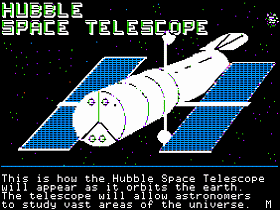 NASA releases an interactive electronic educational guide to the upcoming Hubble Space Telescope for the Apple II computer. Featuring diagrams of the orbiting telescope’s construction, methods of communication with Earth, and how it gathers its images. The software is released ahead of HST’s launch aboard an upcoming shuttle flight.
NASA releases an interactive electronic educational guide to the upcoming Hubble Space Telescope for the Apple II computer. Featuring diagrams of the orbiting telescope’s construction, methods of communication with Earth, and how it gathers its images. The software is released ahead of HST’s launch aboard an upcoming shuttle flight.
Windows
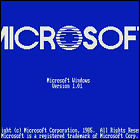 Microsoft introduces a graphical user interface for the IBM PC compatible computers, Windows 1.0. Essentially a GUI shell for Microsoft’s MS-DOS operating system, Windows arrives over two years after it was initially announced in 1983. To avoid legal entanglements with Apple (which has already launched a more visually-pleasing user interface with its Macintosh computers), Microsoft deliberately omits such now common features as overlapping or resizeable windows. Due to the amount of RAM in most users’ PCs, Windows’ multitasking ability is extremely limited.
Microsoft introduces a graphical user interface for the IBM PC compatible computers, Windows 1.0. Essentially a GUI shell for Microsoft’s MS-DOS operating system, Windows arrives over two years after it was initially announced in 1983. To avoid legal entanglements with Apple (which has already launched a more visually-pleasing user interface with its Macintosh computers), Microsoft deliberately omits such now common features as overlapping or resizeable windows. Due to the amount of RAM in most users’ PCs, Windows’ multitasking ability is extremely limited.
The Oregon Trail reborn
 The Minnesota Educational Computing Corporation releases a new version of the perennial favorite educational computer game The Oregon Trail for the Apple II computer. Now featuring more action-based sequences than purely textual interactions, this version of The Oregon Trail is the most recognizable iteration of the game, which will be ported to numerous other computer systems.
The Minnesota Educational Computing Corporation releases a new version of the perennial favorite educational computer game The Oregon Trail for the Apple II computer. Now featuring more action-based sequences than purely textual interactions, this version of The Oregon Trail is the most recognizable iteration of the game, which will be ported to numerous other computer systems.
The first .com
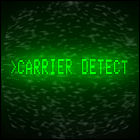 Massachusetts computer manufacturer Symbolics Inc., a maker of LISP-based computers with customers ranging from the Defense Advanced Research Projects Agency (DARPA) to movie studios, registers the first .com internet domain name, symbolics.com. Ironically, despite being further ahead of the internet curve than nearly any other commercial entity, Symbolics struggles to last into the 1990s; both the company’s assets and its domain name will be sold off in the 21st century.
Massachusetts computer manufacturer Symbolics Inc., a maker of LISP-based computers with customers ranging from the Defense Advanced Research Projects Agency (DARPA) to movie studios, registers the first .com internet domain name, symbolics.com. Ironically, despite being further ahead of the internet curve than nearly any other commercial entity, Symbolics struggles to last into the 1990s; both the company’s assets and its domain name will be sold off in the 21st century.
Apple IIc
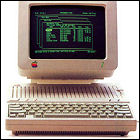 Not quite ready to bring the Apple II line to an end, Apple Computer launches the Apple IIc, a smaller form-factor enhanced Apple IIe specifically designed for portability (an optional LCD monitor – with no backlighting – is also made available on this date). Introduced alongside the IIc is a new Apple operating system, ProDOS, meant to mimic some of the object-oriented features of the Macintosh user interface, as well as an Apple II mouse. Perhaps not surprisingly, Apple also chooses to quietly discontinue support for the Apple III on this date as well.
Not quite ready to bring the Apple II line to an end, Apple Computer launches the Apple IIc, a smaller form-factor enhanced Apple IIe specifically designed for portability (an optional LCD monitor – with no backlighting – is also made available on this date). Introduced alongside the IIc is a new Apple operating system, ProDOS, meant to mimic some of the object-oriented features of the Macintosh user interface, as well as an Apple II mouse. Perhaps not surprisingly, Apple also chooses to quietly discontinue support for the Apple III on this date as well.
Apple Macintosh
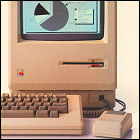 Apple Computer releases a new home and business computer, the Macintosh, with a sharp black & white display and an eye-grabbing, object-oriented graphical user interface. Early software includes the what-you-see-is-what-you-get (WYSIWYG) word processor MacWrite and the graphics program MacPaint, the combination of which jumpstarts an entire new industry, “desktop publishing” – typesetting via computer instead of manual layout. This decisive step away from the now-seven-year-old Apple II architecture is Apple’s answer to the IBM PC.
Apple Computer releases a new home and business computer, the Macintosh, with a sharp black & white display and an eye-grabbing, object-oriented graphical user interface. Early software includes the what-you-see-is-what-you-get (WYSIWYG) word processor MacWrite and the graphics program MacPaint, the combination of which jumpstarts an entire new industry, “desktop publishing” – typesetting via computer instead of manual layout. This decisive step away from the now-seven-year-old Apple II architecture is Apple’s answer to the IBM PC.
This is the ending of the age of Aquarius
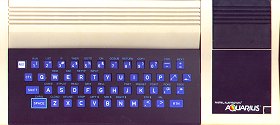 Having taken heavy losses and criticism from both the public and the computing press for launching an underpowered machine into the burgeoning personal computer market, Mattel Electronics hurriedly sells off its interest in the Aquarius Computer, handing all rights in the machine back to its UK-based originator, Radofin Electronics. The age of Aquarius has lasted less than a year, but has cost Mattel Electronics dearly.
Having taken heavy losses and criticism from both the public and the computing press for launching an underpowered machine into the burgeoning personal computer market, Mattel Electronics hurriedly sells off its interest in the Aquarius Computer, handing all rights in the machine back to its UK-based originator, Radofin Electronics. The age of Aquarius has lasted less than a year, but has cost Mattel Electronics dearly.
Aquarius
 Trying to join the ranks of game companies producing home computers, Mattel Electronics licenses a low-end computer from a Hong Kong manufacturer and releases it in the United States as the Aquarius home computer. The age of Aquarius is short-lived, however, as Mattel is incurring serious losses from slowing Intellivision sales, and the Aquarius computer quickly proves to be underpowered next to even its cheapest competitors (the Mattel programmers tasked with creating games and software for it refer to it as the “system for the ’70s”).
Trying to join the ranks of game companies producing home computers, Mattel Electronics licenses a low-end computer from a Hong Kong manufacturer and releases it in the United States as the Aquarius home computer. The age of Aquarius is short-lived, however, as Mattel is incurring serious losses from slowing Intellivision sales, and the Aquarius computer quickly proves to be underpowered next to even its cheapest competitors (the Mattel programmers tasked with creating games and software for it refer to it as the “system for the ’70s”).
IBM Personal Computer
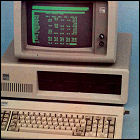 IBM Model 5150, developed under the code name “Chess” but better known as the IBM Personal Computer, is released, including the original PC edition of Microsoft’s MS-DOS. This not only marks the ascendency of Microsoft as a maker of operating systems, but a sudden shift away from a multitude of other computer platforms (especially the Apple II series) toward the IBM PC. Within a year, the first IBM PC-compatible machine will arrive on the market, but while that begins to cost IBM its hardware market share, it popularizes the Intel-8088-based architecture and makes it the standard of the computer industry.
IBM Model 5150, developed under the code name “Chess” but better known as the IBM Personal Computer, is released, including the original PC edition of Microsoft’s MS-DOS. This not only marks the ascendency of Microsoft as a maker of operating systems, but a sudden shift away from a multitude of other computer platforms (especially the Apple II series) toward the IBM PC. Within a year, the first IBM PC-compatible machine will arrive on the market, but while that begins to cost IBM its hardware market share, it popularizes the Intel-8088-based architecture and makes it the standard of the computer industry.
Small area networks on microcomputers
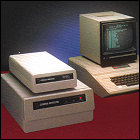 Corvus Systems, makers of hard disk drives for the Apple II and other microcomputers, releases the Corvus OmniNet, the first local area networking hardware/software bundle aimed at small businesses, schools, and even high-end home users. Since Corvus’ 5 and 10 megabyte hard disk drives for the Apple II had initial price tags in the $5,000 range, Corvus also created the OmniNet hub to allow small businesses and schools to maximize that investment by allowing multiple computers to access it. Forseeing the future of the business market, Corvus also makes OmniNet cards for the IBM PC. Though Ethernet is already in use at this time, its expensive hardware and installation is generally limited to large business customers.
Corvus Systems, makers of hard disk drives for the Apple II and other microcomputers, releases the Corvus OmniNet, the first local area networking hardware/software bundle aimed at small businesses, schools, and even high-end home users. Since Corvus’ 5 and 10 megabyte hard disk drives for the Apple II had initial price tags in the $5,000 range, Corvus also created the OmniNet hub to allow small businesses and schools to maximize that investment by allowing multiple computers to access it. Forseeing the future of the business market, Corvus also makes OmniNet cards for the IBM PC. Though Ethernet is already in use at this time, its expensive hardware and installation is generally limited to large business customers.
Osborne I Portable Computer
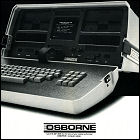 The Osborne One portable computer is given its public debut at the West Coast Computer Faire in San Francisco. Despite being billed as “portable”, the computer is huge – packing 5¼” floppy disk drives and a tiny CRT monitor and a full-sized keyboard into a suitcase-sized enclosure, it weighs at least 30 pounds. The Osborne I’s native operating system is CP/M.
The Osborne One portable computer is given its public debut at the West Coast Computer Faire in San Francisco. Despite being billed as “portable”, the computer is huge – packing 5¼” floppy disk drives and a tiny CRT monitor and a full-sized keyboard into a suitcase-sized enclosure, it weighs at least 30 pounds. The Osborne I’s native operating system is CP/M.
Apple III
 Apple Computer introduces the newest upgrade of its Apple II architecture, the oversized Apple III computer, aimed squarely at the business computing market that Apple has stumbled into as a result of VisiCalc‘s success. The monolithic machine suffers from technical problems from the outset, resulting in recalls and repairs to most early adopters’ Apple III units. With barely 100,000 units sold over three years, Apple pulls the Apple III off the market before 1984 is out.
Apple Computer introduces the newest upgrade of its Apple II architecture, the oversized Apple III computer, aimed squarely at the business computing market that Apple has stumbled into as a result of VisiCalc‘s success. The monolithic machine suffers from technical problems from the outset, resulting in recalls and repairs to most early adopters’ Apple III units. With barely 100,000 units sold over three years, Apple pulls the Apple III off the market before 1984 is out.
Microsoft Z80 Softcard
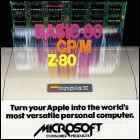 Microsoft enters the computer hardware business with a Z80 processor card for the Apple II computer. This peripheral allows the Apple II to run the CP/M operating system and Microsoft BASIC (the Apple II is well on its way to dominating the home computer market at this point). Selling it for nearly $350 is responsible for bringing in the bulk of Microsoft’s revenue between now and the introduction of Microsoft DOS for the IBM PC.
Microsoft enters the computer hardware business with a Z80 processor card for the Apple II computer. This peripheral allows the Apple II to run the CP/M operating system and Microsoft BASIC (the Apple II is well on its way to dominating the home computer market at this point). Selling it for nearly $350 is responsible for bringing in the bulk of Microsoft’s revenue between now and the introduction of Microsoft DOS for the IBM PC.
Hard drives at home
 Corvus Systems introduces its Winchester hard disk drive for the Apple II computer, available with five or ten megabytes of storage. A bulky device requiring its own power supply independent of the computer to which it’s connected, the Winchester drive carries a $5,000 price tag and an unconventional data backup system, Corvus Mirror, which uses videocassettes (also a fairly new technology). As the investment in this new mass storage technology is fairly daunting, Corvus will introduce a networking system the following year to allow multiple computers access to a single hard drive.
Corvus Systems introduces its Winchester hard disk drive for the Apple II computer, available with five or ten megabytes of storage. A bulky device requiring its own power supply independent of the computer to which it’s connected, the Winchester drive carries a $5,000 price tag and an unconventional data backup system, Corvus Mirror, which uses videocassettes (also a fairly new technology). As the investment in this new mass storage technology is fairly daunting, Corvus will introduce a networking system the following year to allow multiple computers access to a single hard drive.
Flight TE901
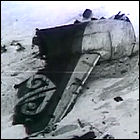 Air New Zealand Flight 901, a sightseeing flight making a round trip to Antarctica and then back to Auckland without landing, is lost with all hands when it crashes into the slopes of Mt. Erebus in Antarctica. Later investigations reveal that the flight crew and passengers were doomed by a typo made during autopilot data entry, switching the plane’s course from a low-altitude flyover of MacMurdo Sound to a low-altitude collision course with the mountain. (Also uncovered are the great lengths taken by Air New Zealand to accuse the crew of incompetence.) The steps taken to uncover the truth mark the birth of modern air disaster investigation, and the end of Antarctic sightseeing flights for at least a decade.
Air New Zealand Flight 901, a sightseeing flight making a round trip to Antarctica and then back to Auckland without landing, is lost with all hands when it crashes into the slopes of Mt. Erebus in Antarctica. Later investigations reveal that the flight crew and passengers were doomed by a typo made during autopilot data entry, switching the plane’s course from a low-altitude flyover of MacMurdo Sound to a low-altitude collision course with the mountain. (Also uncovered are the great lengths taken by Air New Zealand to accuse the crew of incompetence.) The steps taken to uncover the truth mark the birth of modern air disaster investigation, and the end of Antarctic sightseeing flights for at least a decade.
Atari Home Computers
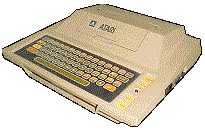 Atari introduces the Atari 400 and Atari 800 home computers, one of the company’s first major product lines to show the imprint of Warner Communications. With only 8K of RAM (expandable to 16K), the Atari 400 (shown here) is intended to be more of a game machine, while the 48K Atari 800, with an actual keyboard, is intended to make inroads into the increasingly crowded home computer market. The same basic architecture, with significant modifications, will form the core of Atari’s next-generation video game console, the Atari 5200, which will be released in 1982.
Atari introduces the Atari 400 and Atari 800 home computers, one of the company’s first major product lines to show the imprint of Warner Communications. With only 8K of RAM (expandable to 16K), the Atari 400 (shown here) is intended to be more of a game machine, while the 48K Atari 800, with an actual keyboard, is intended to make inroads into the increasingly crowded home computer market. The same basic architecture, with significant modifications, will form the core of Atari’s next-generation video game console, the Atari 5200, which will be released in 1982.
CBBS: first computer bulletin board system
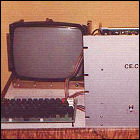 Programmers Ward Christensen and Randy Suess put their brainchild, the CBBS or Computer Bulletin Board System, online for the first time. Accessible to anyone with a computer modem and a phone line, CBBS allows users to log in one at a time since the system is limited to a single phone line; messages both public and private can be posted. Christensen and Suess become the first SysOps, or System Operators, responsible for both technical maintenance and moderation of the system’s content. Similar bulletin board systems spring up across America and elsewhere (indeed, in the late 1980s, theLogBook itself will be launched as a series of text files on such a BBS).
Programmers Ward Christensen and Randy Suess put their brainchild, the CBBS or Computer Bulletin Board System, online for the first time. Accessible to anyone with a computer modem and a phone line, CBBS allows users to log in one at a time since the system is limited to a single phone line; messages both public and private can be posted. Christensen and Suess become the first SysOps, or System Operators, responsible for both technical maintenance and moderation of the system’s content. Similar bulletin board systems spring up across America and elsewhere (indeed, in the late 1980s, theLogBook itself will be launched as a series of text files on such a BBS).
Apple II
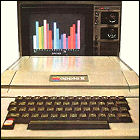 Apple Computer introduces the Apple II home computer system, an already-built 4K computer (with an optional upgrade to 48K) capable of displaying color graphics on a TV or monitor, and storing programs on either cassette or floppy disk. The computer ships with an implementation of BASIC written by Steve Wozniak, with an optional pair of paddle controllers for games. The system also has an open architecture, with space for expansion cards (and no restriction on what cards can be developed, or by whom).
Apple Computer introduces the Apple II home computer system, an already-built 4K computer (with an optional upgrade to 48K) capable of displaying color graphics on a TV or monitor, and storing programs on either cassette or floppy disk. The computer ships with an implementation of BASIC written by Steve Wozniak, with an optional pair of paddle controllers for games. The system also has an open architecture, with space for expansion cards (and no restriction on what cards can be developed, or by whom).
Apple I
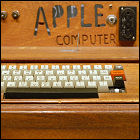 The Apple I computer is available for sale, for the price of $666.66, a price set as a practical joke by Apple Computer cofounder Steve Wozniak, who is also the designer of the system’s architecture. The computer is sold as a circuit board, requiring end users to construct their own enclosure to protect it (the elaborate wood casing shown here was neither typical nor standard-issue). Wozniak’s ambitions for an expandable system are built into the Apple I, including add-on memory cards that can expand its native 4K of memory to as much as 48K, with an interface for an optional cassette data storage system. Nearly 200 units are built and sold, but Apple will recall them, offering users an opportunity to upgrade to the Apple II upon that system’s introduction the following year.
The Apple I computer is available for sale, for the price of $666.66, a price set as a practical joke by Apple Computer cofounder Steve Wozniak, who is also the designer of the system’s architecture. The computer is sold as a circuit board, requiring end users to construct their own enclosure to protect it (the elaborate wood casing shown here was neither typical nor standard-issue). Wozniak’s ambitions for an expandable system are built into the Apple I, including add-on memory cards that can expand its native 4K of memory to as much as 48K, with an interface for an optional cassette data storage system. Nearly 200 units are built and sold, but Apple will recall them, offering users an opportunity to upgrade to the Apple II upon that system’s introduction the following year.
Micro-Soft BASIC
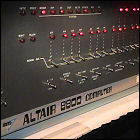 Having formed a company mere months before, Micro-Soft – in the persons of young Bill Gates and Paul Allen – make good on their sales pitch to develop a workable BASIC programming language for the Altair 8800 microcomputer. The manufacturer of the Altair, MITS, licenses Micro-Soft BASIC from Gates and Allen, who have put college and everything else on hold to move to Albuquerque to work with the company. Over the next few years, the newly-founded Micro-Soft will create versions of BASIC for other emerging computer systems, and will collide with the free-sharing ethos of computer hobbyist groups, resulting in some of the earliest accusations of computer software piracy.
Having formed a company mere months before, Micro-Soft – in the persons of young Bill Gates and Paul Allen – make good on their sales pitch to develop a workable BASIC programming language for the Altair 8800 microcomputer. The manufacturer of the Altair, MITS, licenses Micro-Soft BASIC from Gates and Allen, who have put college and everything else on hold to move to Albuquerque to work with the company. Over the next few years, the newly-founded Micro-Soft will create versions of BASIC for other emerging computer systems, and will collide with the free-sharing ethos of computer hobbyist groups, resulting in some of the earliest accusations of computer software piracy.
Games with cartridges
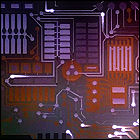 Alpex Corporation, an American computer company, files “the ‘555 Patent” for a “television display control apparatus” capable of loading software from ROM chips embedded in swappable cartridges and other media. This patent effectively shifts the infant video game industry from a hardware-based model to a software-based model, and is licensed by Fairchild Semiconductor for the first cartridge-based video game, the Fairchild Video Entertainment System (later known as Channel F), a year later; the resulting sea change forces a sudden reassessment in the R&D departments at Atari and Magnavox, among others. Due to the remarkably broad nature of patent #4026555, Alpex will be able to take nearly every video game manufacturer to court to force them to license the technology from Alpex through the early ’90s. The first major challenge to Alpex’s patent will come from Nintendo in 1986, a case that will eventually make its way to the U.S. Supreme Court in 1997 – by which time Alpex will go bankrupt pursuing the case.
Alpex Corporation, an American computer company, files “the ‘555 Patent” for a “television display control apparatus” capable of loading software from ROM chips embedded in swappable cartridges and other media. This patent effectively shifts the infant video game industry from a hardware-based model to a software-based model, and is licensed by Fairchild Semiconductor for the first cartridge-based video game, the Fairchild Video Entertainment System (later known as Channel F), a year later; the resulting sea change forces a sudden reassessment in the R&D departments at Atari and Magnavox, among others. Due to the remarkably broad nature of patent #4026555, Alpex will be able to take nearly every video game manufacturer to court to force them to license the technology from Alpex through the early ’90s. The first major challenge to Alpex’s patent will come from Nintendo in 1986, a case that will eventually make its way to the U.S. Supreme Court in 1997 – by which time Alpex will go bankrupt pursuing the case.